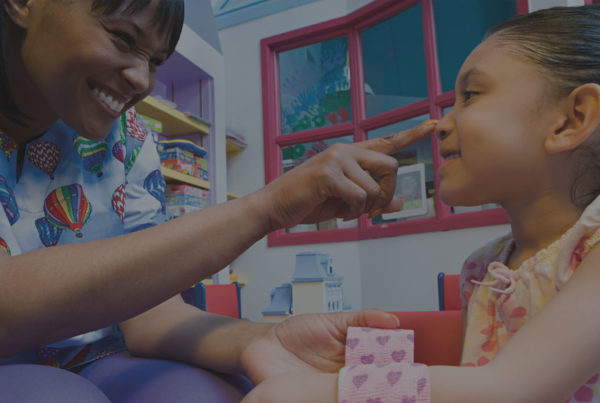When TV Was Our Biggest Concern
Twenty-five years ago, pediatricians, educators, and parents began to voice concerns about the effects of watching television on children’s health. Was the dramatic increase in childhood obesity linked to the parallel increase in screen time? Did the sex, violence, and drug use available on cable television influence health-related risk behaviors among youth? As a former filmmaker turned pediatrician, I was asked by both patients and health organizations like the American Academy of Pediatrics to assess and respond to these concerns.
The understandable reflex of many was “Turn it off!” Since Congressional hearings in the early 1950s that questioned whether “Gunsmoke” led to juvenile delinquency, there had been a values-based, polarized discourse about the effects of television between advocates for children and proponents of free speech. After four decades of debate, it was clear that, despite the concerns, screen media were becoming an increasingly prominent part of our environment. As a pediatrician and a parent, I realized that the same rigorous research that we had brought to bear on nutrition and injury prevention was needed for us to learn to live with screen media in healthy and safe ways. We needed to replace the heat of controversy with the light of science.
Reframing the Paradigm
Approaching screen media as a public health influence rather than a social threat, I founded the Center on Media and Child Health (CMCH) in 2002 at Boston Children’s Hospital and Harvard Medical School. CMCH is the first (and so far only) academic center of excellence that builds on rigorous scientific evidence to understand and respond to the positive and negative effects of media as a powerful environmental influence on the physical, mental, emotional, and social health of children, adolescents, and the adults they will become.
The work of the Center’s interdisciplinary team, including experts in developmental psychology, information science, cultural anthropology, education, and medicine, is focused around its mission of “nurturing children’s health and development in media-rich environments.” Building on a comprehensive library of international scientific findings, CMCH conducts clinical research to provide all stakeholders, from children and families to health professionals to producers of media and technology, with unbiased findings on the positive and negative ways that children and adolescents are affected by the media they use and how they use them. This research is translated into effective tools for parents, educators and clinicians to direct those influences toward positive outcomes. CMCH shares information and strategies with professionals and the public through its web and social media outreach, as well as through academic and popular press publications, formal research presentations, and educational lectures throughout the world.
Lost and Found in our Googleable Globe
It goes without saying that our media environment has evolved dramatically since CMCH started to bring science to our lives with screens. Now, screens are everywhere; unsurprisingly, today’s 8 to 12-year olds are exposed to 6 hours of media daily, while 13 to 18-year-olds are exposed to an average of 9 hours—more time than they spend in school or with parents (Rideout, 2015).. Many children, even very young children, now have smartphones, using them effortlessly to connect, to learn, to communicate, and to never be bored. The ubiquity of mobile devices and the infiltration of screens into virtually every aspect of human society has created an environment in which we all move seamlessly between the physical and the digital worlds.
CMCH seeks to understand screen media effects as an environmental health issue, using evidence to develop best practices for introducing these powerful tools to children and for using them in ways that help and do no harm.
Growing Up Healthy in a Screen-Saturated World
History has proven that a Luddite approach of “turning off” is a non-starter. Experience with screen time limits has shown that restricting screens makes them the even-more-desirable “forbidden fruit.” And at a time when homework is assigned online and kids have multiple windows open on multiple devices, determining how much time is spent with “good” vs. “not so good” media is frustrating and practically impossible. We must accept that screen media are completely integrated into the environment in which children are growing up.
CMCH is translating our scientific understanding of how children’s health and development are affected by their screen use into best practices for children and families to use these very powerful tools. CMCH’s research and clinical experience does not support handing these mobile devices to children at any age, nor does it point to today’s tech use as the sole cause of children’s problems. Instead, it reveals the importance of moving past our long-held preconceptions and fears to build on science-based understanding of the complex interfaces and influences of three moving targets: the developing child, the evolution of media technology, and the transformation of human behaviors in our use of these innovations. With rigorous understanding of how children’s health and development are affected by the media we use and how we use them, we can make informed decisions to introduce these digital tools to children when they need them, and once they have demonstrated their ability to utilize them in ways that will benefit who they are and where they are developmentally.
When Connectedness Becomes a Clinical Concern
In my research at CMCH and my medical practice at Boston Children’s Hospital, it became clear that there was a need for identifying and treating children who have health issues related to their media use. Not only were we treating children with medical issues such as obesity which were exacerbated by their media use, we began seeing increasing numbers of young people who were unable to self-regulate their use of screen media:
- Some were sleep-deprived because they stayed up late texting.
- Social media users were increasingly anxious and depressed.
- All-night gamers would sleep through school.
- Porn users were struggling with sexual dysfunction.
- Teens would opt out of family meals, social events, even basic hygiene because they were watching endless online videos.
We saw impairments in academic, social, and emotional functioning akin to those seen among young people with serious psychiatric illness or substance use disorders.
“Internet Addiction Disorder”is a recognized diagnosis in Korea and China, and “Internet Gaming Disorder”is noted to require further research in the Diagnostic and Statistical Manual of Mental Disorders (DSM-5) (American Psychiatric Association, 2013), and “Gaming Disorder”appears likely to be included in the World Health Organization’s (WHO) International Classification of Diseases (ICD-11) (World Health Organization, 2016). But noneof these descriptions accurately characterizes the scope and specifics of what we are seeing in the clinical setting. As a label, addictionis both inaccurate and stigmatizing, resulting in parents not recognizing a developing problem until it is much harder to manage. The forms of dysregulated media use we have seen have not been limited to gaming or even the internet. The problem is not created by the device or application, but by young people’s behaviors with them. Children and adolescents can become just as out-of-control offline as online – it is the interactivity that draws them in and holds them.
As a result, we have found Problematic Interactive Media Use (PIMU)to be the most accurate descriptor ofdysregulated use of computers, mobile devices, or consoles, online or offline, which results in functional impairment of the individual.
We have observed four distinct manifestations of PIMU:
- gaming (predominantly boys)
- social media (predominantly girls)
- pornography
- and information-bingeing, linking from site to site watching videos or reading text.
Although the interactive activities differ, PIMU is a unifying description ofa behavioral syndrome characterized by compulsive use of, increasing tolerance, and negative reactions to being removed from interactive screen media which impairs the individual’s physical, mental, cognitive, and/or social function. While uncontrolled use of screen media can cause problems at any age, children and adolescents are more vulnerable than adults to develop PIMU due to still-developing executive brain function (Rich et al, 2017).
Intervening and Preventing
In response to observed increases in PIMU and other media-related health problems, CMCH has built on its evidence base to provide diagnosis and treatment at the Clinic for Interactive Media and Internet Disorders (CIMAID – http://cmch.tv/cimaid/), based at the Adolescent/Young Adult Clinic of Boston Children’s Hospital. CIMAID is a multidisciplinary team of psychologists, psychiatrists, and medical doctors who evaluate patients presenting with media-related health concerns and develop treatment strategies for them. Because PIMU is yet to be fully characterized, the CIMAID team is collecting clinical data on our patients and finding that many have an underlying disorder such as Attention Deficit-Hyperactivity Disorder (ADHD), anxiety, or depression, often previously subclinical and unnoticed, which has manifested itself in the interactive screen environment. Young people with social anxiety sought connection through social media, but got caught up in competitive self-marketing that exacerbated their anxiety. Kids with ADHD took refuge from the chaotic world in the predictable confines of gaming, but then saw no reason to leave the environment that they had mastered for one in which they felt inadequate and out of control.
When CIMAID has identified and treated the underlying dysfunction, PIMU symptoms have frequently subsided, allowing these young people to manage their media use in functional ways and succeed in school, at home, and with friends. What our ongoing clinical research appears to show is that while PIMU may be a more accurate description for this problem, in fact it may not be a new diagnosis but a syndrome – a group of symptoms that uniquely present themselves in the interactive screen environment. In addition to developing and evaluating treatments, CIMAID has focused on identifying predispositions and vulnerabilities to PIMU, information that can be incorporated into pediatric care, education, and parenting strategies for how to introduce and use these powerful interactive tools in children’s lives.
We Need an App for That
Media and technology have profoundly changed the way we live our lives, from how we communicate and connect with others to how we educate ourselves and navigate our world. While we benefit from media used mindfully, we must recognize that they can present risks to our health and well-being. As the public has become aware of these risks, ranging from PIMU and other health issues to personal data being hacked, we are now experiencing a “techlash”, in which even internet and social media industry pioneers are questioning what they have unleashed. Google faces public distrust after thousands of disturbing videos were posted (and watched) on their “safe” YouTube Kids channel. Facebook is undergoing Congressional scrutiny for sharing personal data, and Apple must respond to major shareholders about negative effects their smartphones may have on children.
Parents, clinicians, educators, policymakers, indeed most of us who have ever felt beholden to our phones, are worried by what we see, read, and even how we find ourselves acting in our new “connected” and “smart” environment. But we have the science and clinical experience to understand how we are being affected, to prevent and intervene on problematic uses of interactive media, and to teach our children and ourselves to use these media in mindful, focused ways so that they, and the society that they will soon lead, develop to be healthy, happy, productive and caring.
We have and must cultivate an inborn app for that – the ability to think critically about why and how we are using these powerful tools, and the awareness that when we use them, we are always displacing something else, something that might be as valuable as a conversation, a human touch, or a moment simply being present.
References
American Psychiatric Association. (2013). Diagnostic and statistical manual of mental disorders (5th ed.). Arlington, VA: American Psychiatric Publishing. Retrieved from: https://www.psychiatry.org/File%20Library/Psychiatrists/Practice/DSM/APA_DSM-5-Internet-Gaming-Disorder.pdf
Rich, M., Tsappis, M., and Kavanaugh, J.R. (2017). Problematic Interactive Media Use among children and adolescents: Addiction, compulsion, or syndrome? In Young, K.S. and de Abreu, C.N. (Eds). Internet addiction in children and adolescents: Risk factors, assessment, and treatment.New York, NY: Springer Publishing Company, pp. 3-28.
Rideout, V. (2015). The Common Sense Census: Media use by tweens and teens. San Francisco, CA: Common Sense Media. Retrieved from:
https://www.commonsensemedia.org/sites/default/files/uploads/research/census_researchreport.pdf
World Health Organization (2018). ICD-11 Beta Draft (Mortality and Morbidity Statistics): 6C71 Gaming disorder. Retrieved from https://icd.who.int/dev11/l-m/en#/http%3a%2f%2fid.who.int%2ficd%2fentity%2f1448597234
Research Support
Jill R. Kavanaugh, MLIS, AHIP
 Michael Rich, MD, MPH, FAAP, FSAHM, Founder and Director of the Center on Media and Child Health (CMCH) at Boston Children’s Hospital, Associate Professor at Harvard Medical School and Harvard School of Public Health, came to medicine after a twelve-year career as a filmmaker. As Director of CMCH, Dr. Rich combines his creative experience with rigorous scientific evidence about the powerful positive and negative effects of media to advise pediatricians and parents how to use media in ways that optimize child development. Recipient of the AAP’s Holroyd-Sherry Award and the SAHM New Investigator Award, Dr. Rich has developed media-based research methodologies and authored numerous papers and AAP policy statements, and has testified to the United States Congress.
Michael Rich, MD, MPH, FAAP, FSAHM, Founder and Director of the Center on Media and Child Health (CMCH) at Boston Children’s Hospital, Associate Professor at Harvard Medical School and Harvard School of Public Health, came to medicine after a twelve-year career as a filmmaker. As Director of CMCH, Dr. Rich combines his creative experience with rigorous scientific evidence about the powerful positive and negative effects of media to advise pediatricians and parents how to use media in ways that optimize child development. Recipient of the AAP’s Holroyd-Sherry Award and the SAHM New Investigator Award, Dr. Rich has developed media-based research methodologies and authored numerous papers and AAP policy statements, and has testified to the United States Congress.
 Kristelle Lavallee, MA, is the Content Strategist at the Center on Media and Child Health in the Division of Adolescent and Young Adult Medicine at Boston Children’s Hospital. A former educator and media producer, Kristelle’s current work focusses on translating CMCH and other relevant interdisciplinary research into actionable advice, practical health resources, and through curricula that promote children’s healthy and developmentally optimal creation and consumption of media.
Kristelle Lavallee, MA, is the Content Strategist at the Center on Media and Child Health in the Division of Adolescent and Young Adult Medicine at Boston Children’s Hospital. A former educator and media producer, Kristelle’s current work focusses on translating CMCH and other relevant interdisciplinary research into actionable advice, practical health resources, and through curricula that promote children’s healthy and developmentally optimal creation and consumption of media.






